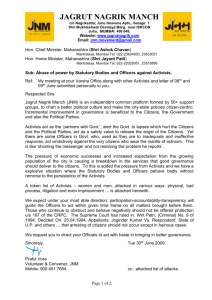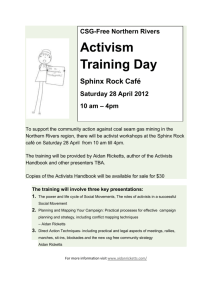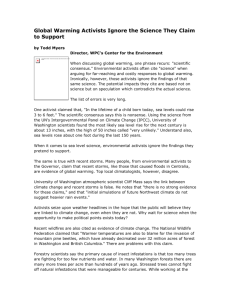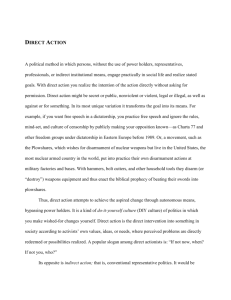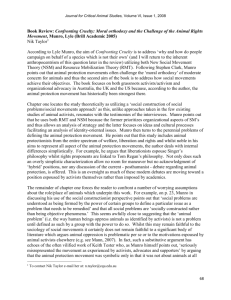Luddites or Limits - Animal Liberation Front
advertisement
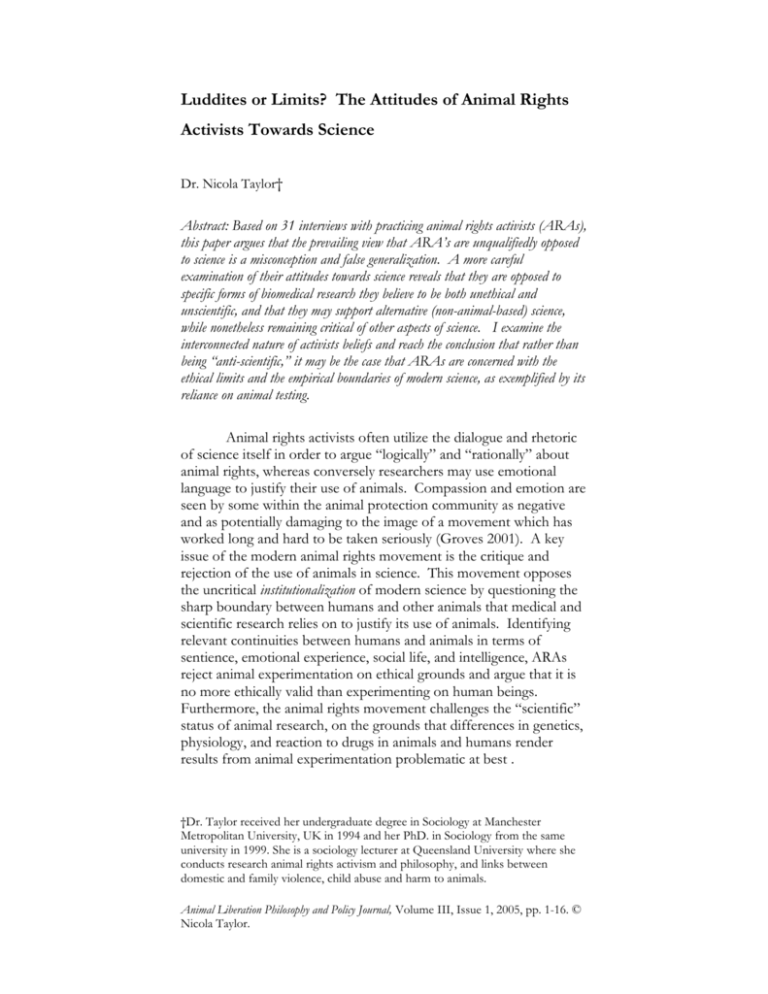
Luddites or Limits? The Attitudes of Animal Rights Activists Towards Science Dr. Nicola Taylor† Abstract: Based on 31 interviews with practicing animal rights activists (ARAs), this paper argues that the prevailing view that ARA’s are unqualifiedly opposed to science is a misconception and false generalization. A more careful examination of their attitudes towards science reveals that they are opposed to specific forms of biomedical research they believe to be both unethical and unscientific, and that they may support alternative (non-animal-based) science, while nonetheless remaining critical of other aspects of science. I examine the interconnected nature of activists beliefs and reach the conclusion that rather than being “anti-scientific,” it may be the case that ARAs are concerned with the ethical limits and the empirical boundaries of modern science, as exemplified by its reliance on animal testing. Animal rights activists often utilize the dialogue and rhetoric of science itself in order to argue “logically” and “rationally” about animal rights, whereas conversely researchers may use emotional language to justify their use of animals. Compassion and emotion are seen by some within the animal protection community as negative and as potentially damaging to the image of a movement which has worked long and hard to be taken seriously (Groves 2001). A key issue of the modern animal rights movement is the critique and rejection of the use of animals in science. This movement opposes the uncritical institutionalization of modern science by questioning the sharp boundary between humans and other animals that medical and scientific research relies on to justify its use of animals. Identifying relevant continuities between humans and animals in terms of sentience, emotional experience, social life, and intelligence, ARAs reject animal experimentation on ethical grounds and argue that it is no more ethically valid than experimenting on human beings. Furthermore, the animal rights movement challenges the “scientific” status of animal research, on the grounds that differences in genetics, physiology, and reaction to drugs in animals and humans render results from animal experimentation problematic at best . †Dr. Taylor received her undergraduate degree in Sociology at Manchester Metropolitan University, UK in 1994 and her PhD. in Sociology from the same university in 1999. She is a sociology lecturer at Queensland University where she conducts research animal rights activism and philosophy, and links between domestic and family violence, child abuse and harm to animals. Animal Liberation Philosophy and Policy Journal, Volume III, Issue 1, 2005, pp. 1-16. © Nicola Taylor. 2 This two-fold critique, whether implied or overt, has led many to argue that the animal rights movement is anti-science and antiprogress (e.g. Sperling 1988), and ultimately anti-human and misanthropic (e.g. Franklin, 1999). This paper argues that those within the animal rights movement are not necessarily anti-science per se, but rather are concerned with the ethical limits and scientific boundaries of animal reliant biomedical research. The position that ARAs are opposed to science per se because they reject animal experimentation conflates key distinctions in the animal rights critique of science, and thus relies on a false generalization and overly simplistic position by characterizing the animal rights movement as unified or monolithic in its ideologies or politics. While there are differences within the animal rights movement itself, there are even more significant differences between “animal welfare” and “animal rights” stances which need to be noted (see, for example, Francione 1996, Taylor 1999). Animal welfare is an anthropocentric philosophy based on the presumption that it is acceptable to utilize animals for human means so long as they are not caused any “unnecessary” suffering (e.g. Appleby & Hughes 1997). This position actually affirms the value of at least some animal experimentation and serves to move the debate away from whether it is ethically acceptable to use animals in the first place to a discussion of what constitutes unacceptable or unnecessary forms of animal suffering. Welfarists take heart in requirements in recent years to force researchers to give better consideration to animal welfare as a sign or moral progress. This position, however, is still based on the notion that it is acceptable to use animals to improve human lives, an assumption rejected by rights advocates. Animal rights proponents argue that animals have basic rights, including the right to life and bodily integrity, and thus reject the human “prerogative” to use animals for the “betterment” of humanity. These ideological differences between rights and welfare advocates often lead to the adoption of different tactics, such as reflected in the difference between “bigger cages” and “empty cages.” Whilst welfarists work for the reduction of animal suffering within existing conditions of exploitation and inequality, rights advocates seek the abolition of animal slavery altogether and argue that animals have the same basic moral rights as humans (for further discussion, see Garner 1993). Many ARAs, moreover, point out that the notion of “welfare” is little but a mask that science “hides behind” to legitimate cruelty and unethical experiments, and lull the public into thinking it is doing responsible research (see Birke & Michael, 1994; Regan 2005). Thus, it is important to keep in mind that the activists interviewed here adopt an animal rights orientation, and were dismissive of the anthropocentric logic of welfarism and skeptical of welfare claims made on behalf of science. Moreover, as I will show, Animal Liberation Philosophy and Policy Journal, Volume III, Issue 1, 2005, pp. 1-16. © Nicola Taylor. 3 many ARAs have a more general critique of science as a domineering, mechanistic paradigm and practice, and show how such a form of science relates to destructive capitalist institutions1. Nonetheless, they do not believe that science is bad in all aspects or that it cannot be constituted in some other form, and thus they are not “anti-science” in any facile or unqualified way. I. Method This paper is based on 31 interviews with people who identify themselves as animal rights activists. Contact was made through a university animal rights group in the UK. There were 23 females and 8 males who agreed to be interviewed. This gender imbalance is representative of a movement which consistently shows higher female participation than male (e.g. Garner, 1993). Participants ranged in age from 16 to 46 years and their average length of involvement in animal rights was 3 years. The majority were unemployed, often deliberately, or employed in part-time work, to allow time for their considerable animal rights activities. The remainders were professionals and included a university lecturer, a veterinarian, and a journalist. The interviews lasted between 60 and 90 minutes and were in-depth and unstructured. As well as collecting demographic information such as age, gender and occupation the interviews sought to elicit information around very broad aspects regarding the lifestyles, philosophies, and beliefs of animal activists. For example, interviewees were asked to outline their philosophical beliefs, their participation in animal rights activism, and their views of modern science. In place of a quantitative method that attempts to build a wall of “objectivity” between the interviewer and subjects, the approach adopted here was a qualitative one that allowed the respondent to fully elaborate their beliefs and feelings regarding particular topics. The qualitative method is fruitful in that it allows the researcher to work closely with the subjects interviewed to present an in-depth look at their lives without deciding for them which are the issues of interest. It also allows for a more reflexive study as it permits the researcher to respond to new, previously unforeseen, issues which are raised by the respondents during the course of the research. While baseline statistical data (i.e. underlying statistics which allow comparisons over time) concerning the attitudes of animal activists (e.g. Herzog et al, 1991) have been gathered previously, such information is unlikely to present a realistic picture of the day-to-day 1 For a detailed discussion concerning the ways in which a mechanistic science, i.e. one which views animals and nature as machines thereby giving humans ”permission” to exploit and manipulate them, see Carolyn Merchant (1980), The Death of Nature: Women, Ecology, and the Scientific Revolution. Animal Liberation Philosophy and Policy Journal, Volume III, Issue 1, 2005, pp. 1-16. © Nicola Taylor. 4 lives of activists. Such data also does not necessarily give the respondents a chance to clarify their beliefs and/or statements. Although a qualitative approach -- i.e. one based on in-depth interviews rather than one which elicits quantitative data -- will not necessarily “fix” all of these problems, the adoption of such a paradigm will allow for a reflexive process of discovery that is essential to this research project, and arguably, this topic as a whole. A qualitative approach also has the added advantage of lending itself to sensitive research attempting to access “hard-to-reach” populations. For the purposes of this research, “animal rights activists” were taken to be anyone who identified themselves as believing in the moral and ethical need for animal rights, such that prohibit their use in experimental research, in contrast to “animal welfare” as discussed above, which shares the anthropocentric values of science and merely seeks to minimize animal suffering. Whilst defining a nebulous and contested term such as “science” is near impossible, I adopt a sociological definition which views science as a distinct type of “truth-seeking” knowledge about the natural world and organic life, such as is derived from formulating and testing hypotheses, predicting and verifying outcomes, and use of experimental procedures. As a social enterprise reliant on shared paradigms and research communities, science is a socially-produced form of knowledge that constructs different views and paradigms as its assumptions change. Moreover, as an entrenched societal institution, science represents an uncritically accepted way of knowing the world and one which is granted a superior status to other ways of knowing the world. II. Results Interviews undertaken for this project indicate that animal rights activists may well belong to a number of different pressure groups concerned with a variety of causes, e.g., anti-globalization, ecologism, feminism, and so on, and thus they adopt a holistic mode of activist informed by an understanding of relations among interconnected social and political issues. All of the activists interviewed, bar one, belonged to and were active in more than one political group and just under half of them belonged to and were active in three or more groups. This involvement often stemmed from a general recognition of the links between attitudes to animals and a wider social critique. As one activist explained: For me, it’s about more than animal rights as well. It’s about the whole sort of system, the capitalist system and how it exploits everyone and not just animals. It’s more than animal rights, it’s the whole big thing, it’s like an anarchist thing I suppose, it’s being opposed to a lot of things. You can’t be Animal Liberation Philosophy and Policy Journal, Volume III, Issue 1, 2005, pp. 1-16. © Nicola Taylor. 5 into AR without being against a whole lot of things or for a lot of things as well. This holistic activism was often based on recognition of the wider social and political implications of the critique of animal experimentation. The connection between the human use of the environment and of animals was self-evident and important to the activists interviewed here. In the words of one activist: I really feel deep down inside that what we do to animals, and to the earth on the whole, is wrong …. It’s based on the idea that we have got it all wrong, we think we are above nature, are superior to it and can control it. I think, no I know, that we are all part of the same thing – we are a part of nature and part of the environment, and not a better part, just a part. If you believe that then how can we take it upon ourselves which bits of nature we can use and abuse? … We’ve become really arrogant in all the wrong ways and we think that everything is there for us and because of us and not despite us. There was a pervasive belief among the activists that humans are arrogant and have “gone too far” in their “control” of the planet and in their belief that they can, and indeed should, control or manipulate nature for their own purposes and gain: If we are all a part of one big thing – nature – then there should be no hierarchy – we aren’t at the top, we aren’t better than them [non-human animals], we don’t get to use them for our own purposes, that’s not our decision to make. So I just don’t think that we should be using animals, and the earth, in the ways in which we do. The concepts of “control” and “domination” were prevalent throughout many of the interviews and were often contrasted with more holistic definitions of humanity’s place within nature. The complaints about the ways in which humans treat animals “for their own purposes” often centered around the fact that humans are a part of nature and yet they act as though they own it. One activist put the point this way: It’s like we’ve got it all wrong, all turned around somehow – we don’t control nature and we shouldn’t want to – we are simply a part of it. Given this belief in the basic connectedness of all living things, the fact that humans use animals for their own purposes is Animal Liberation Philosophy and Policy Journal, Volume III, Issue 1, 2005, pp. 1-16. © Nicola Taylor. 6 seen as morally wrong and inextricably linked to the way in which humans see the planet. That is, humans are perceived as treating nature as a commodity to be bought and sold. This is an outlook which the animal rights activists interviewed here object to: We think that we can buy anything but money is a human creation not natural and nature doesn’t understand the laws of money so its pointless to say I’ll use all these trees but I’ll give you money for them … yet that’s how we think, and it makes me mad and very sad at the same time – we have no conception of what we are doing and eventually we are going to kill everything off and usually in the name of progress. The belief that many humans treat both non-human animals and nature as commodities to be utilized to maximize profit extended to the activists’ beliefs about science. Thus their holistic outlook and activism was based on the general critique of an oppressive social system seen as underpinning the institution of modern science: I think it is linked to the fact that we see animals as our property to be exploited in the same way as any other resource regardless of dangers, ethics and so on. III. Animal Rights Activists and the Boundaries of Science Many of the activists who participated in this study mentioned the fact that they felt profit often dictated the way scientists and lab workers think about and use animals in research. There was a general consensus that science itself was not necessarily “wrong” but “misguided. In particular, activists tended to argue that modern science is linked to the pursuit of profit at the expense of everything else. This constant focus on the bottom line was then seen to preclude any moral or ethical behavior on the part of science, and often individual scientists themselves. Thus, the activists made a clear connection between capitalism, the search for profit, and the uncritical acceptance of institutionalized science by the majority of the public: Usually money and profit are the driving force, but it’s about lots of things…. Our desire to control, our desire to make money and profit, the way we need to feel superior, the ways in which we define superiority, the fact that we feel that we have to use animals to make any progress in anything, the way in which science has argued away all animal feelings just so it can justify their use, the way in which this is presented as the only way of doing things rather than looking for alternatives. But here again you see it comes down to money – we wouldn’t need to use as may animals as we do if we Animal Liberation Philosophy and Policy Journal, Volume III, Issue 1, 2005, pp. 1-16. © Nicola Taylor. 7 looked into alternatives but animals are cheap and alternatives are not so we use the animals and present it to people as a matter of life and death. Well it’s not that simple, you don’t choose animals over people, you don’t have to, it’s just presented that way so no one really has to analyze what they’re doing. If scientists were willing to use alternatives to animal testing exclusively, then their research would be acceptable to a number of activists, as one activist explained: There are alternatives, we just don’t get told about them enough so people accept that we should use animals … I don’t agree with it at all, it’s putting us as more important than them which isn’t fair, but even if you accept that we need to do medical testing then there are alternatives. I mean, it’s not like I am against progress for the most part. Given that it is the use of animals within science that causes the most consternation amongst animal rights activists, if animal testing were to be removed from science it is possible that an acceptance of science, or at least the room to negotiate one, could be gained from activists. Portraying all activists as anti-science and antiprogress is simplistic and impedes any meaningful dialogue between activists and researchers. Rather than being unqualifiedly “antiscience,” animal activists are concerned with the (ethical) limits and (empirical) boundaries of modern science. Yet, apart from its use of animals, many activists see modern science as mired in a false and dangerous mechanistic framework that is closely linked to capitalist attitudes and the pursuit of power and profit: I wouldn’t say I am against science completely, it’s not like I’m a Luddite or anything, I just don’t like how far it’s gone today. We need to put the brakes on and think about what we are doing to ourselves, animals and the planet a bit more. The cloning and genetic engineering we are into at the minute really scares me – it’s pushing the boundaries too far. We don’t know what we are going to end up with and trying to find out does not legitimate what we are actually doing. It’s not natural. We have this natural life span that we should just accept and get on with enjoying what we have whether it’s short or long. Many activists cited examples from current debates in genetic engineering and these seemed to highlight their anxieties over the Animal Liberation Philosophy and Policy Journal, Volume III, Issue 1, 2005, pp. 1-16. © Nicola Taylor. 8 human control of nature. Again, in the eyes of the activists this was linked to profit and the institutionalized nature of science: It’s just stupid, you and me, we won’t be able to afford these spare parts and we will die normally at the right time … it’s about money and power and class, it’s about everything – so much more than just using animals in the wrong way – so why don’t people outside the movement see this? One of the reasons why genetic engineering was often singled out for criticism was that it was here, at the forefront of modern technological advances, that they were most likely to see science spinning out of control. It also represents the underlying ideology of modern, post-Cartesian dualistic science which follows the biomedical model of seeing humanity and its wider environs as discrete, mechanistic parts to be manipulated: It’s not like I am against progress for the most part although I don’t agree with genetic engineering – I think we are playing with stuff we have no idea about the consequences of. I’m not even against science I just don’t like the way it’s going today. There has to be a time when you say ‘stop, enough is enough’ we don’t need animals with kidneys growing out of their ears, what we do need is a science that makes sense, science that helps us all … and by that I mean all of us, animals, the planet, helps us all as an integrated system not one which knackers the system by prioritizing the needs of one part of it over another. Whilst some activists indicate they may be willing to accept science if the use of animals in research were to cease, there are a number who explain that they cannot accept science in its current guise. They see science as intrinsically linked with exploitative and inegalitarian social, political, and economic systems: I can’t say I’m against science, I could even accept a different kind of science. Trouble is I can’t begin to see how that science would shape up. Under a capitalist system there’s not one institution that can be fair and that goes double for science. It’s linked to profit and big business so how on earth can it ever change while that system exists? Interviews conducted here with animal activists indicate that they are not simplistically anti-science nor are they anti-progress. Rather, their worldview involves a holistic conception of the planet and nature and of humans’ place within that system. This leads to their questioning many of the values that humans take for granted, Animal Liberation Philosophy and Policy Journal, Volume III, Issue 1, 2005, pp. 1-16. © Nicola Taylor. 9 namely that it is morally, ethically, and schematically acceptable to view non-human nature as a commodity which can, and should, be used to further the needs, desires and interests of humanity. Given that much scientific research rests upon the use of animals and given that this research is often presented as being in the best interests of humans, science lends itself naturally as a target for the animal rights movement which questions human superiority over the planet and its non-human inhabitants: It’s like a world gone mad innit? I mean, how far can we go, what more do they want to do, we have ears growing on mice, we have pigs being bred for human parts, we have mice and other animals bred with cancer deliberately so we can see what its effects are. I mean, we know its effect, it kills, and nastily. What are they gonna come up with next? IV. An Anti-Science Movement? Numerous theories abound concerning the modern animal rights movement. These include arguments that it is primarily a women’s movement based on a perceived link between the oppression of women and their bodies and an oppression of animals and their bodies (e.g. Elston 1987; Groves 2001); that it is antiprogress (e.g. Horton 1989); that it is anti-science (e.g. Clark 1990; Guither 1998; Sperling 1988; Takooshian 1988); that it is antiinstrumentalist (e.g. Jasper & Nelkin 1992), that it uses public skepticism towards science to advance its cause (e.g. Jasper & Nelkin 1992), and that, due to its anti-science stance, it is also misanthropic (e.g. Franklin, 1999). Science is problematical within the animal rights movement, but it is the use of animals that is of concern, not science per se, although, as shown above, many activists are critical of science in general to the extent it views the world as resources for manipulation and brings destructive results. The use of animals in scientific research was, and remains, an issue that many animal activists consider paramount. For example, Plous (1991) surveyed 402 animal rights activists and found that the majority (54%) identified “animals used in research” as the issue the animal rights movement should focus on most. In a follow up study of 372 activists in 1996 he concluded that if there were any significant changes in acticvists opposition to animals used in research it came not in degree of opposition but in type of research targeted and attitudes towards illegal laboratory break-ins (Plous 1996). Similarly, examinations of the philosophical animal rights literature indicate a high level of concern over the use of animals in science (e.g. Fox 2000, 2001; Singer 1975). A concerted study of animal rights groups’ literature calculated that its “concern-to-use” ratio for animal research was 659 times higher than that concerned with animal agriculture. In other Animal Liberation Philosophy and Policy Journal, Volume III, Issue 1, 2005, pp. 1-16. © Nicola Taylor. 10 words, for every page of animal agriculture discussion there were 659 pages of discussion concerning the use of animals in science (Nicoll & Russell 1990). It is therefore not surprising that some have represented the situation between animal activists and the scientific research community as a “state of war” (Gluck & Kubacki 1991). However this is a superficial and erroneous representation of a movement which is infinitely complex in its make-up, ideologies, and actions (Herzog 1993; Garner 1993, 1995). It is possible that the advance of science and technology explains why so many found a resonance in the movement precisely when they did; that animal activists are not simply anti-science but are concerned with the limits and boundaries of science. This should not, however, be interpreted as an argument that animal protectionism is fundamentally anti-science for this is too simplistic. Nor should this be taken to be an argument that those within animal protection movements are simply “using” the movement as a vehicle to protest about science more generally, for this would be a disservice to those in the movement who clearly articulate their concerns for animals per se. Rather, this should be seen as one particular tool for explaining why animal protectionism became influential precisely when it did. Sperling argues that anti-vivisection and animal rights have both developed at moments of broad cultural debate about the boundaries between human organism and machine (1988, p. 131). Both movements have also been concerned with the increasing hold of science over humanity, and specifically with the boundaries of science. French argues that in the nineteenth century anti-vivisection became a specific example of the general question “will science not recognize its moral limits?” (1975, p. 350). According to French, the nineteenth century anti-vivisection movement emerged at a time when science, and in particular medical science, was becoming the dominant paradigm for all other forms of knowledge. It has been argued that it was in direct opposition to this institutionalization of science that the anti-vivisection movement was born (e.g. French 1975; Sperling 1988). Encapsulated within this campaign against vivisection was a general critique of science and a questioning of the limits of science, and, in particular, whether it was legitimate to put to use knowledge gained from the pain and suffering of others (e.g. Elston 1987). Sperling explicitly links fear over the extent of the power of science to the rise of the nineteenth century anti-vivisection movement. Further, she argues that a corollary of this can be found in the modern animal rights movement which represents, at least in part, a backlash against the increasing influence of science and technology on human lifestyles and attitudes: Animal Liberation Philosophy and Policy Journal, Volume III, Issue 1, 2005, pp. 1-16. © Nicola Taylor. 11 In the nineteenth century the human body was the perceived focus of medicine’s assault, as the animal body was the focus of assault by experimental psychologists … in the modern period, the technological invasion is of the whole of nature – the vivisection of our planet. In a series of complex transformations the animal as victim has become a symbol of both humanity and nature besieged. The modern animal rights movement has expanded the Victorian focus, which was almost exclusively on the scientific domination of the body, to include the manipulation and domination of nature as a whole (1988 p. 139). Sperling goes on to claim that animal rights activists are essentially anti-science in their outlook, which I am arguing is an over-generalization. It may well be that animal activists are more concerned with the limits and boundaries of modern science. Such a flawed science is essentially anthropocentric and mechanistic. It is, in other words, based on the belief that humans can, and should, seek to understand and manipulate natural processes (including other animals’ bodies) by technological means for the perceived betterment of human beings. This modern, secular, “Enlightenment” view of science, ironically enough, encapsulates the Judeo-Christian belief concerning the place of humans within the world. This belief became firmly entrenched in modern thought, as exemplified by the idea of a Scala Natura with humans sitting perched firmly at the top of this hierarchy (Thomas, 1982) and the domineering views of Bacon, Descartes, Boyle, and other trailblazers of modern science. The Enlightenment, in its secular crusade against bigotry, intolerance and irrationality (which were regarded as the hallmarks of preenlightened thought) touted the notion that Truth was discoverable via the application of reason, and thereby embedded science, with its attendant “neutrality” and “objectivity,” as the superior way of interpreting and seeing reality. Furthermore, the notion of the scientific method became firmly entrenched within modern thinking, as the key way to elicit the Truth. One side effect of this was that it clearly allowed the institution of science, if not individual scientists, to avoid accountability for both the outcome of their work and the methods used to reach them. Hiding behind the mask of “objectivity,” scientists thereby could neatly sidestep the profound ethical questions raised by use of animals in their research (see Michael & Birke 1994). Thus science became inextricably associated with both an empirical and experimental method and a hierarchical and domineering outlook and practice. It was this positioning of science which helped entrench its anthropocentric ideology which, in turn, cemented the belief prevalent under modern capitalism that nonhuman animals are little more than commodities to be used to benefit their human Animal Liberation Philosophy and Policy Journal, Volume III, Issue 1, 2005, pp. 1-16. © Nicola Taylor. 12 “masters.”. It would seem that those interviewed here, who demonstrated a high level of interconnected activism and critique of current political and social practices, recognized the role both science and technology have made, and continues to make, to the development of capitalism and the exploitation of all nature. V. Boundary Work Arluke and Sanders argue that humans are constantly involved in “boundary work – the drawing and blurring of lines of demarcation between humans and animals” (1996, p. 133). These boundaries are essential to lend order to the world in which we live, allowing us to make sense of our everyday existence. The boundary between human and animal is, however, an arbitrary one which is subject to constant flux and re-negotiation: “Natural” taken for granted dichotomies, such as human versus animal, can assume various meanings and uses even during the same time and in the same place (Arluke & Sanders 1996, p. 166). The boundary between human and animal, whatever specific criteria it is based on at the time, rests on the notion that non-human animals are different, that they are “other” to our humanity. It also serves the practical purpose in everyday life whereby it allows us to make sense of our relationships with, and use of, animals. For example, the ways in which animals become scientific “tools” emphasize the “distancing” process that scientists use in order to make sense of their use of animals in research (e.g. Lynch 1988). Arluke & Sanders argue that “to become tools … their animal nature must be reconstructed as scientific data … to accomplish this transformation, animals must be deanthropomorphosized, becoming lesser beings or objects that think few thoughts, feel only the most primitive emotions, and experience little pain” (1996, p. 173). The animal rights activists interviewed here directly confront and reject such boundaries. In seeing nature holistically and in seeing humans as simply one constituent part of that nature they are deliberately rejecting the notion of animals as “other” and the idea that humans are somehow superior and set apart from the rest of nature. This then fits into a philosophical schema which calls for a recognition of the inalienable rights of animals (and often the planet) in much the same way that humans are seen to have, and are accorded, basic inalienable rights. As one activist summed up: I fight for animals because animas are not our property or resources to exploit for our own ends. They should be accorded rights as should the planet in general. They are no Animal Liberation Philosophy and Policy Journal, Volume III, Issue 1, 2005, pp. 1-16. © Nicola Taylor. 13 different to us. We are all part of this world and not one of us has the right to decide who is more part of it than the other. Conclusion Humans socially construct meanings of animals as they endeavor to make sense of them and their relationship to them in the general scheme of nature. These meanings are based on a wider acceptance of the species boundary and almost always result in the non-human animal being constructed as an inferior other to humanity. Despite the fact that social constructions of animals change over time, they change for the most part within the dominant paradigm which upholds the species boundary. It is at the forefront of science and technology that these boundaries are both maintained and blurred: maintained because science often justifies its use of animals by constructing them as different and inferior to humans, and blurred because animals need to have some similarities to humans if they are to be of use to science in the first place. It is therefore not surprising that the uncritical acceptance of modern portrayals of science has become a target for animal activists who sharply critique this division between humans and non-human animals. However, as I have demonstrated, the argument that animal rights activists are anti-science is groundless. Listening carefully to activists demonstrates that the issue is far more complex than this. Indeed, many activists indicate support for a science that does not use animals, but are contemptuous of the way in which institutionalized science presents the use of animals in research as necessary. Much of the animal rights literature and rhetoric surrounding scientific research calls for a systematic and significant investigation into possible alternatives to the use of animals (e.g. Hill 2000). A large part of this are the various campaigns for humane research that many animal rights groups run (e.g. Animal Aid, UK) and campaigns to investigate alternatives to animal testing (e.g. BUAV,UK). By their very existence they indicate that animal rights activism, at least in its larger-scale institutionalized form is not simply anti-science but for a science that does not use animals. The data presented here drawn from animal activists in the UK corroborates this argument in that the activists explicitly claim not to be antiscience but to be anti-the-use-of-animals-in-science. The attitudes of animal rights activists is an under-researched area and what little research there is tends to rest on prevalent stereotypes and generic conceptions of animal rights activists as an homogenous group (for some notable exceptions see Groves 2001; Herzog 1993; Munro 2001) which is clearly inaccurate. Animal activists come from all walks of life and hold a number of different viewpoints. Perhaps if we started listening to animal activists instead of relying on media stereotypes which are often drawn from the extreme minority of occasionally violent activists we will be able to Animal Liberation Philosophy and Policy Journal, Volume III, Issue 1, 2005, pp. 1-16. © Nicola Taylor. 14 institute meaningful dialogue between activists and researchers and break the so-called “state of war” between them. References Appleby, M. C. and Hughes, B. O. 1997. Animal Welfare. CAB International: Oxford. Arluke, A., & Sanders, C. 1996. Regarding animals. Temple University Press:Philadelphia. Bentham, J. 1948. Introduction to the principles of morals and legislation. Hafner Publishing: New York. Birke, L. and Michael, M. 1998. “The heart of the matter: Animal bodies, ethics and species boundaries,” Society & Animals 6: 245-262. Birke, L. & Michael, M. 1994. “Accounting for animal experiments: Identity and disreputable `others’,” Science, Technology & Human Values, 19(2) p. 189. Clark, L. 1990. “The animal rights movement threatens to make scientists an endangered species,” The Scientist, September 3. Elston, M. 1987. Women and anti-vivisection in Victorian England, In Vivisection in historical perspective. Ed. Ruupke, N. Croom Helm: London. Fox, M. 2000. “The case against animal experimentation,” Organization & Environment 13:463-510. Fox, M. 2001. “Tooling with Mother Nature: The dangers of genetic engineering,” The Animals' Agenda 21: 22-26. Francione, G. 1996. “Animal rights and animal welfare,” Rutgers Law Review 48: 397. Franklin, A. 1999. Animals and Modern Cultures : A Sociology of Human-Animal Relations in Modernity. Sage. London. French, R. 1975. Anti-vivisection and medical science in Victorian society. Princeton University Press: Princeton. Gardner, A. and Gardner, B. 1969. “Teaching sign language to a chimpanzee,” Science 165:666. Garner, R. 1995. “The road to Shoreham: Ideological and political aspects of the evolution of the British animal rights movement,” paper presented to the Alternative Futures and Popular Protest Conference, Manchester Metropolitan University, 1995. Garner, R. A. 1993. Animals, politics & morality. Manchester University Press: Manchester. George, A. 1998. “Biotechnology in medicine,” in Animal biotechnology and ethics. Eds, Holland, A. and Johnson, A. Chapman Hall: London. Animal Liberation Philosophy and Policy Journal, Volume III, Issue 1, 2005, pp. 1-16. © Nicola Taylor. 15 Gluck, J. and Kubacki, S. 1991. “Animals in biomedical research: The undermining effect of the rhetoric of the besieged.” Ethics & Behaviour 1: 157-173. Groves, J. M. 2001. “Animal rights and the politics of emotion: Folk constructions of emotion in the animal rights movement,” in Passionate politics: Emotions and social movements. Eds, Goodwin, J., Jasper, J., & Nelkin, D. and Polletts, F. The University of Chicago Press: Chicago. Guither, H. 1998. Animal rights: History and scope of a radical social movement. Southern Illinois University Press. Herzog, H., Betchart, N. and Pittman, R. 1991. Sex role identity and attitudes toward animals. Anthrozoös 4(3):184-192. Herzog, H. 1993. ‘The movement is my life: the psychology of animal rights activism,”. Journal of Social Issues 49(1): 103-17. Holland, A. and Johnson, A. 1998. Animal biotechnology and ethics. Chapman Hall: London. Horton, L. 1989. “The enduring animal issue, Journal of the National Cancer Institute,” 81: 736-743. Jasper, J., & Nelkin, D. 1992. The animal rights crusade: The growth of a moral protest. The Free Press: New York. Lawrence, E. 1994. “Conflicting ideologies: Views of animal rights advocates and their opponents.” Society & Animals 2: 175190. Lynch, M. 1988. “Sacrifice and the transformation of the animal body into a scientific object,” Social studies of science 18: 265289. Munro, L. 2001. Compassionate beasts: The quest for animal rights. Praeger: Connecticut. Nicoll, C., & Russell, S. 1990. “Analysis of animal rights literature reveals the underlying motives of the movement,” Endocrinology 127: 985-989. Ohnuki-Tierney, E. 1994. “Brain death and organ transplantation,” Current anthropology 35: 233-242. Paul, E. 1995. “Us and them: Scientists and animal rights campaigners views of the animal experimentation debate,” Society & Animals 3: 1-21. Plous, S. 1991. “An attitude survey of animal rights activists,” Psychological Science 2: 194-196. Plous, S. 1998. “Signs of change within the animal rights movement: Results from a follow up survey of activists,” Journal of comparative psychology 112: 48-54. Premack, D., & Premack, A. 1972. “Teaching sign language to an ape,” Scientific American 227: 95. Regan, T. 2005. Empty cages: Facing the challenge of animal rights. Rowman & Littlefield Publishers, Inc. Sheehan, J. 1991. Boundaries of humanity: Humans, animals and machines. University of California Press: Berkeley. Animal Liberation Philosophy and Policy Journal, Volume III, Issue 1, 2005, pp. 1-16. © Nicola Taylor. 16 Singer, P. 1975. Animal liberation. HarperCollins: London. Sperling, S. 1988. Animal liberators: Research and morality. University of California Press: Berkeley. Takooshian, H. 1988. “Opinions on animal research: Scientists' versus the public,” PsyETA Bulletin 7: 5-7. Taylor, N. 1999. “Whither rights? Animal rights and the emergence of 'new welfarism’,” Animal Issues 3: 27-43. Thomas, K. (1982). Man and the natural world: Changing attitudes in England 1500-1800. Oxford University Press. Woods, T. 1998. “Have a heart: Xenotransplantation, nonhuman death and human distress,” Society & Animals 6: 47-66. Animal Liberation Philosophy and Policy Journal, Volume III, Issue 1, 2005, pp. 1-16. © Nicola Taylor.
